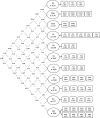Validation of a measurement instrument for parental child feeding in a low and middle-income country
- PMID: 30454059
- PMCID: PMC6245694
- DOI: 10.1186/s12966-018-0736-7
Validation of a measurement instrument for parental child feeding in a low and middle-income country
Abstract
Background: Parental child feeding practices (PCFP) are a key factor influencing children's dietary intake, especially in the preschool years when eating behavior is being established. Instruments to measure PCFP have been developed and validated in high-income countries with a high prevalence of childhood obesity. The aim of this study was to test the appropriateness, content, and construct validity of selected measures of PCFP in a low and middle-income country (LMIC) in which there is both undernutrition and obesity in children.
Methods: An expert panel selected subscales and items from measures of PCFP that have been well-tested in high-income countries to measure both "coercive" and "structural" behaviors. Two sequential cross-sectional studies (Study 1, n = 154; Study 2, n = 238) were conducted in two provinces in Indonesia. Findings of the first study were used to refine subscales used in Study 2. An additional qualitative study tested content validity from the perspective of mothers (the intended respondents). Factorial validation and reliability were also tested. Convergent validity was tested with child nutritional status.
Results: In Study 1, a confirmatory factor analysis (CFA) model with 11 factors provided good fit (RMSEA = 0.045; CFI = 0.95 and TLI = 0.95) after two subscales were removed. Reliability was good among seven of the subscales. Following a decision to take out an additional subscale, the instrument was tested for factorial validity (Study 2). A CFA model with 10 subscales provided good fit (RMSEA = 0.03; CFI = 0.92 and TLI = 0.90). The reliability of subscales was lower than in Study 1. Convergent validity with nutrition status was found with two subscales.
Conclusions: The two studies provide evidence of acceptable psychometric properties for 10 subscales from tested instruments to measure PCFP in Indonesia. This provides the first evidence of the validity of these measures in a LMIC setting. Some shortcomings, such in the reliability of some subscales and further tests of predictive validity, require further investigation.
Keywords: Child feeding practices; Indonesia; Parental child feeding; Validation.
Conflict of interest statement
Ethics approval and consent to participate
Ethics approvals for Study 1 were obtained from the Human Research Ethic Committee, University of New South Wales, Australia, and the Human Ethics Committee, Faculty of Medicine (HC15303), University of Lampung (No. 1740/UN26/8/DT/2015). Ethics approvals for Study 2 were obtained from the Human Research Ethics Committee, University of New South Wales, Australia (HC15826), and the Medical and Health Research Ethics Committee, Universitas Gadjah Mada, Indonesia (KE/FK/196/EC/2016). All research activities in Lampung and Yogyakarta provinces were approved by local governments (Research and Development Department and the District Health Offices). Informed consent was obtained in writing from all participants before data collection in all phases.
Consent for publication
Not applicable (this manuscript does not contain any individual details, images or videos. Only aggregate data were used in this publication).
Competing interests
The authors declare that they have no competing interests.
Publisher’s Note
Springer Nature remains neutral with regard to jurisdictional claims in published maps and institutional affiliations.
Figures


Similar articles
-
A cultural adaptation and validation of a child eating behaviour measure in a low- and middle-income country.Public Health Nutr. 2020 Aug;23(11):1931-1938. doi: 10.1017/S136898001900510X. Epub 2020 May 8. Public Health Nutr. 2020. PMID: 32383413 Free PMC article.
-
Associations between Parental Concerns about Preschoolers' Weight and Eating and Parental Feeding Practices: Results from Analyses of the Child Eating Behavior Questionnaire, the Child Feeding Questionnaire, and the Lifestyle Behavior Checklist.PLoS One. 2016 Jan 22;11(1):e0147257. doi: 10.1371/journal.pone.0147257. eCollection 2016. PLoS One. 2016. PMID: 26799397 Free PMC article.
-
Validation of the modified Parenting Strategies for Eating and Physical Activity Scale-Diet (PEAS-Diet) in Latino children.Appetite. 2016 Mar 1;98:55-62. doi: 10.1016/j.appet.2015.12.003. Epub 2015 Dec 15. Appetite. 2016. PMID: 26699670 Clinical Trial.
-
[Simple obesity in children. A study on the role of nutritional factors].Med Wieku Rozwoj. 2006 Jan-Mar;10(1):3-191. Med Wieku Rozwoj. 2006. PMID: 16733288 Review. Polish.
-
A review of methods to assess parental feeding practices and preschool children's eating behavior: the need for further development of tools.J Acad Nutr Diet. 2012 Oct;112(10):1578-602, 1602.e1-8. doi: 10.1016/j.jand.2012.06.356. J Acad Nutr Diet. 2012. PMID: 23017568 Review.
Cited by
-
Self-Care Instruments to Measure Nutrition Practices in Children and Parents: Psychometric Analysis.Nutrients. 2021 Jun 29;13(7):2242. doi: 10.3390/nu13072242. Nutrients. 2021. PMID: 34209989 Free PMC article.
-
Behavioural and environmental risk factors associated with primary schoolchildren's overweight and obesity in urban Indonesia.Public Health Nutr. 2023 Aug;26(8):1562-1575. doi: 10.1017/S1368980023000897. Epub 2023 May 4. Public Health Nutr. 2023. PMID: 37138496 Free PMC article.
-
A cultural adaptation and validation of a child eating behaviour measure in a low- and middle-income country.Public Health Nutr. 2020 Aug;23(11):1931-1938. doi: 10.1017/S136898001900510X. Epub 2020 May 8. Public Health Nutr. 2020. PMID: 32383413 Free PMC article.
-
Validation of the Family Health Behavior Scale for the Brazilian population.J Pediatr (Rio J). 2022 Jan-Feb;98(1):84-91. doi: 10.1016/j.jped.2021.04.002. Epub 2021 May 6. J Pediatr (Rio J). 2022. PMID: 33965407 Free PMC article.
References
-
- McCaffree J. Childhood eating patterns: the roles parents play. J Acad Nutr Diet. 2003. 10.1016/j.jada.2003.10.03. - PubMed
Publication types
MeSH terms
LinkOut - more resources
Full Text Sources
Medical
Miscellaneous

